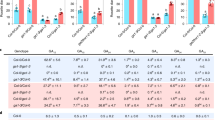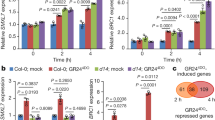Abstract
Touch can lead to a reduction in plant growth and a delay in flowering time. Touch-induced changes in plant morphology, termed thigmomorphogenesis, have been shown to depend on the phytohormone jasmonate1. However, touch-induced phenotypes are also reminiscent of plants deficient in the phytohormone gibberellin2. Here we assess the effect of touch on wild-type Arabidopsis plants and mutants deficient in gibberellin signalling. We show that touch leads to stunted growth and delayed flowering in wild-type plants, as expected. These touch-induced changes in morphology are accompanied by a reduction in gibberellin levels, and can be reversed through the application of a bioactive form of gibberellin. We further show that touch induces the expression of AtGA2ox7, which encodes an enzyme involved in gibberellin catabolism. Arabidopsis ga2ox7 loss-of-function mutants do not respond to touch, suggesting that this gene is a key regulator of thigmomorphogenesis. We conclude that touch-induced changes in Arabidopsis morphology depend on gibberellin catabolism. Given that AtGA2ox7 helps to confer resistance to salt stress, and that touch can increase plant resistance to pathogens, we suggest that gibberellin catabolism could be targeted to improve plant resistance to abiotic and biotic stress.
This is a preview of subscription content, access via your institution
Access options
Subscribe to this journal
Receive 12 digital issues and online access to articles
$119.00 per year
only $9.92 per issue
Buy this article
- Purchase on Springer Link
- Instant access to full article PDF
Prices may be subject to local taxes which are calculated during checkout



Similar content being viewed by others
References
Chehab, E. W., Yao, C., Henderson, Z., Kim, S. & Braam, J. Arabidopsis touch-induced morphogenesis is jasmonate mediated and protects against pests. Curr. Biol. 22, 701–706 (2012).
Suge, H. Growth and gibberellin production in Phaseolus vulgaris as affected by mechanical stress. Plant Cell Physiol. 19, 1557–1560 (1978).
Monshausen, G. B. & Gilroy, S. Feeling green: mechanosensing in plants. Trends Cell Biol. 19, 228–235 (2009).
Monshausen, G. B. & Haswell, E. S. A force of nature: Molecular mechanisms of mechanoperception in plants. J. Exp. Bot. 64, 4663–4680 (2013).
Hamant, O. Widespread mechanosensing controls the structure behind the architecture in plants. Curr. Opin. Plant Biol. 16, 654–660 (2013).
Braam, J. In touch: plant responses to mechanical stimuli. New Phytol. 165, 373–389 (2005).
Lee, D., Polisensky, D. H. & Braam, J. Genome wide identification of touch and darkness-regulated Arabidopsis genes: a focus on calmodulin like and XTH genes. New Phytol. 165, 429–444 (2005).
Jaffe, M. J. Thigmomorphogenesis: the response of plant growth and development to mechanical stimulation with special reference to Bryonia dioica. Planta 114, 143–157 (1973).
Radi, A., Lange, T., Niki, T., Koshioka, M. & Pimenta Lange, M. J. Ectopic expression of pumpkin gibberellin oxidases alters gibberellin biosynthesis and development of transgenic Arabidopsis plants. Plant Physiol. 140, 528–536 (2006).
Sun, T. P. Gibberellin metabolism, perception and signaling pathways in Arabidopsis. The Arabidopsis Book 6, e0103, http://dx.doi.org/10.1199/tab.0103 (2008).
Achard, P. et al. Integration of plant responses to environmentally activated phytohormonal signals. Science 331, 91–94 (2006).
Colebrook, E. H., Thomas, S. G., Phillips, A. & Hedden, P. The role of gibberellin signalling in plant responses to abiotic stress. J. Exp. Bot. 217, 67–75 (2014).
Daviere, J. M. & Achard, P. Gibberellin signaling in plants. Development 140, 1147–1151 (2013).
Kohli, A., Sreenivasulu, N., Lakshmanan, P. & Kumar, P. P. The phytohormone crosstalk paradigm takes center stage in understanding how plants respond to abiotic stresses. Plant Cell Rep. 32, 945–957 (2013).
Benikhlef, L. et al. Perception of soft mechanical stress in Arabidopsis leaves activates disease resistance. BMC Plant Biol. 13, 133 (2013).
Wild, M. et al. The Arabidopsis DELLA RGA-LIKE3 is a direct target of MYC2 and modulates jasmonate signaling responses. Plant Cell 24, 3307–3319 (2012).
Koini, M. A. et al. High temperature-mediated adaptations in plant architecture require the bHLH transcription factor PIF4. Curr. Biol. 19, 408–413 (2009).
Schomburg, F. M., Bizzell, C. M., Lee, D. J., Zeevaart, J. A. D. & Amasino, R. M. Overexpression of a novel class of gibberellin 2-oxidases decreases gibberellin levels and creates dwarf plants. Plant Cell 15, 151–163 (2003).
Magome, H., Yamaguchi, S., Hanada, A., Kamiya, Y. & Oda, K. The DDF1 transcriptional activator upregulates expression of a gibberellin-deactivating gene, GA2ox7, under high-salinity stress in Arabidopsis. Plant J. 56, 613–626 (2008).
Park, J. H. et al. A knock-out mutation in allene oxide synthase results in male sterility and defective wound signal transduction in Arabidopsis due to a block in jasmonic acid biosynthesis. Plant J. 31, 1–12 (2002).
Yang, D. L. et al. Plant hormone jasmonate prioritizes defense over growth by interfering with gibberellin signaling cascade. Proc. Natl Acad. Sci. USA 109, E1192–E1200 (2012).
Heinrich, M. et al. High levels of jasmonic acid antagonize the biosynthesis of gibberellins and inhibit the growth of Nicotiana attenuata stems. Plant J. 73, 591–606 (2013).
Fernández-Calvo, P. et al. The Arabidopsis bHLH transcription factors MYC3 and MYC4 are targets of JAZ repressors and act additively with MYC2 in the activation of jasmonate responses. Plant Cell 23, 701–715 (2011).
Rieu, I. et al. Genetic analysis reveals that C19-GA 2-oxidation is a major gibberellin inactivation pathway in Arabidopsis. Plant Cell 20, 2420–2436 (2008).
Tyler, L. et al. DELLA proteins and gibberellin-regulated seed germination and floral development in Arabidopsis. Plant Physiol. 135, 1008–1019 (2004).
Boyes, D. C. et al. Growth stage-based phenotypic analysis of Arabidopsis: A model for high throughput functional genomics in plants. Plant Cell 13, 1499–1510 (2001).
Lange, T. et al. Gibberellin biosynthesis in developing pumpkin seedlings. Plant Physiol. 139, 213–223 (2005).
Pimenta Lange, M. J., Knop, N. & Lange, T. Stamen-derived bioactive gibberellin is essential for male flower development of Cucurbita maxima L. J. Exp. Bot. 63, 2681–2691 (2012).
Czechowski, T., Stitt, M., Altmann, T., Udvardi, M. K. & Scheible, W. R. Genome-wide identification and testing of superior reference genes for transcript normalization in Arabidopsis. Plant Physiol. 139, 5–17 (2005).
Zhao, S. & Russell, D. F. Comprehensive algorithm for quantitative real-time polymerase chain reaction. J. Comput. Biol. 12, 1045–1062 (2005).
Acknowledgements
We thank Anja Liebrandt for technical assistance, Sarah Krüger and Arne Schmidt for help growing the plants, and Drs Patrick Achard and Roberto Solano for kindly providing seeds of the global della and the myc2,3,4 mutants, respectively.
Author information
Authors and Affiliations
Contributions
M.J.P.L. and T.L designed and performed the experiments and wrote the manuscript.
Corresponding authors
Ethics declarations
Competing interests
The authors declare no competing financial interests.
Supplementary information
Rights and permissions
About this article
Cite this article
Lange, M., Lange, T. Touch-induced changes in Arabidopsis morphology dependent on gibberellin breakdown. Nature Plants 1, 14025 (2015). https://doi.org/10.1038/nplants.2014.25
Received:
Accepted:
Published:
DOI: https://doi.org/10.1038/nplants.2014.25
This article is cited by
-
Changes in the concentrations and transcripts for gibberellins and other hormones in a growing leaf and roots of wheat seedlings in response to water restriction
BMC Plant Biology (2022)
-
Mechanosensory trichome cells evoke a mechanical stimuli–induced immune response in Arabidopsis thaliana
Nature Communications (2022)
-
Prior exposure of Arabidopsis seedlings to mechanical stress heightens jasmonic acid-mediated defense against necrotrophic pathogens
BMC Plant Biology (2020)
-
Trans-generational inheritance of herbivory-induced phenotypic changes in Brassica rapa
Scientific Reports (2018)



